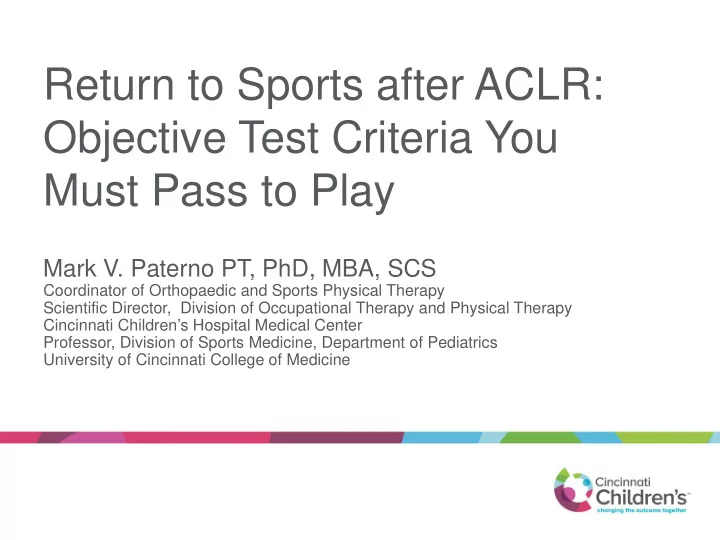

Return to Sports after ACLR: Objective Test Criteria You Must Pass to Play Mark V. Paterno PT, PhD, MBA, SCS Coordinator of Orthopaedic and Sports Physical Therapy Scientific Director, Division of Occupational Therapy and Physical Therapy Cincinnati Children’s Hospital Medical Center Professor, Division of Sports Medicine, Department of Pediatrics University of Cincinnati College of Medicine
Why is this an important topic? 1. Currently our criteria to return an athlete to sport are not well defined. 2. Athletes may be returning to sport prematurely, at high risk 3. Athletes may be restricted from returning to sport based on irrelevant variables 4. Forces us as clinicians to rely on the art, rather than the science of medicine.
CLINICAL QUESTION: When is it safe to return to sports after ACLR? 1. What is “safe”? 2. When is it physically possible to return?
Discussion: Crude Incidence Injury Follow Prop. Up Paterno at al 2012 23.6% 1 year Paterno et al 2014 29.5% 2 year Wright et al 2007 6% 2 year Wright et al 2011 17.2% 5 year Pinczewski et al 2007 27% 10 year
Return to Sports Rates
ACL Return to Sport: Systematic Review Kvist J. “Rehabilitation Following Anterior Cruciate Ligament Injury: Current Recommendations for Sports Participation.” Sports Med 2004: 34(4): 269-280. 34 articles between 1998-2003
Current Criteria for Return to Sport Outline of criteria reported: • 13/34 assessed isokinetic strength • 25/34 used jump testing • 14/34 reported some clinical criteria (i.e. ROM, knee stability etc.) • 4/34 had no assessment of strength or performance Kvist J. Sports Med 2004
Current Criteria for Return to Sport Kvist 2004 • Systematic Review (n=34) • 1/3 : isokinetic testing • 2/3 : functional hop testing Barber-Westin et al 2011 • Systematic Review (n=264) • 40% : no criteria • 13% : objective criteria
Current Return to Sport Measures 1. Time from surgery 2. Strength 3. Knee laxity 4. Functional Performance Testing 5. Patient reported outcomes
Return to Sport Assessment “…low correlations between various hop test scores and self-reported measures of function may indicate that neither of these methods can stand alone as an adequate assessment of knee function.” Fitzgerald GK et al “Hop Tests as Predictors of Dynamic Knee Stability” JOSPT 2001
Current Criteria Grindem et al BJSM 2016 • Failing to pass all D/C criteria at 90 or greater increased risk of re-injury • Included, but not limited to ACL injury Kyritsis et al BJSM 2016 • Failing to meet all D/C criteria = 4 times greater risk of graft rupture • Cohort included male professional soccer players
ACL Return to Sport: What is Missing? 1. Impairments – Balance and Proprioception – Strength – Functional hop testing 2. Quality of movement – Bilateral Asymmetries – Altered movement patterns 3. Psychological Aspects – Fear – Confidence
Biomechanical Measures during Landing and Postural Stability Predict Second Anterior Cruciate Ligament Injury after ACL Reconstruction and Return to Sport Mark V. Paterno PT, PhD, SCS Laura C. Schmitt PT, PhD Kevin R. Ford PhD Mitchell J. Rauh PT, PhD, MPH, FACSM Gregory D. Myer MS, CSCS Bin Huang PhD Timothy E. Hewett PhD, FACSM AJSM 2010
Results: Hip Rotation Net Moment Impulse (Initial 10% of landing)
Results: 2D Frontal Plane Knee Kinematics
Results: Sagittal Plane Moment at Initial Contact
Results: Postural Stability
Results: Predictive Model Area under ROC = 0.94 (Sensitivity = 0.92, Specificity = 0.88) Area under ROC (hip imp. only) = 0.81 (Sen=0.77,Spec = 0.81)
Clinical Factors Predict Second ACL Injury after ACL Reconstruction and Return to Sport: Development of a Clinical Decision Rule Mark V. Paterno PT, PhD, SCS Bin Huang PhD Staci Thomas MS Tim E. Hewett PhD Laura C. Schmitt PT, PhD OJSM 2018
Results Initial N=114 Cohort High Risk Low Risk Risk (22/53) (1/61) 41.5% 1.6% Profile 1 Profile 2 Profile (19/43) (3/10) 44% 30%
Results High Risk Profile 1 High Risk Profile 2 • Young (<19 y/o) • Young (<19 y/o) • TrH Normalized to Height • TrH Normalized to Height (1.34-1.90 X BH) (>1.34 X BH) • TrH Limb Symmetry • TrH Limb Symmetry (<98.5%) (>98.5%) • Female • High Knee Related Confidence
Results: Validation Cohort Validation Cohort with Full N=34 Data Set High Risk Low Risk Risk (6/13) (3/18) 46.2% 16.7% High Risk Group is 5x (OR = 5.14; 95%CI: 1.00-26.46) more likely to suffer a 2 nd ACL injury than the Low Risk Group Sensitivity = 66.7% Specificity = 72% PPV = 46.15% NPV = 85.71%
Summary: Objective Criteria to RTS 1. Strength 2. Hop Testing 3. Balance Strength/Functional 1. Region Performance specific tool 2. Confidence 3. Fear 1. Biomechanical Patient Assessment Quality of Reported Movement 2. Movement Outcome Assessment Tool
Thank you! Mark V. Paterno PT, PhD, MBA, SCS Coordinator of Orthopaedic and Sports Physical Therapy Scientific Director, Division of Occupational Therapy and Physical Therapy Cincinnati Children’s Hospital Medical Center Professor, Division of Sports Medicine, Department of Pediatrics University of Cincinnati College of Medicine mark.Paterno@cchmc.org @mvpaternopt
Recommend
More recommend